A 10-Minute Yoga Practice for Plantar Fasciitis Relief
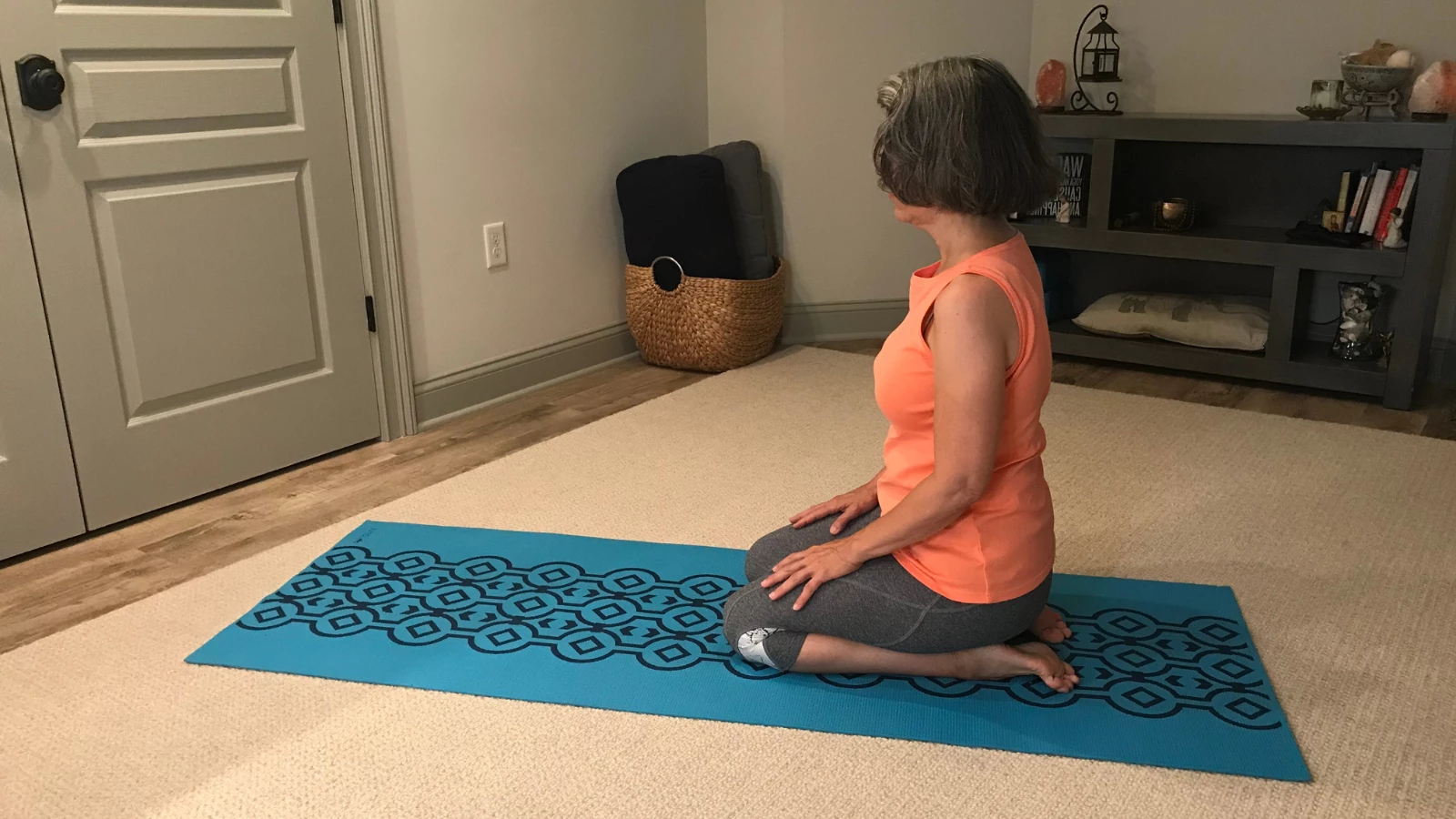
Ah, summertime! No more shoes, time bicycling, walking on the beach and boardwalk. And then, OUCH! Foot pain. With the advent of summer, complaints about foot pain increased. Why? Put simply; it’s our shoes—and plantar fasciitis.
Plantar fasciitis is a common orthopedic complaint that affects one-in-ten adults between the ages of 40 to 60. Most often, the cause is excessive strain on the fascia, or connective tissue, that runs from the heel to the heads of the long bones of the feet, known as the metatarsals. As we transition from more supportive winter shoes to walking barefoot or in shoes with minimal support (such as in flip-flops), there is an increase in stress, irritation, and inflammation of this tissue. If left unchecked, this can lead to micro-tearing. 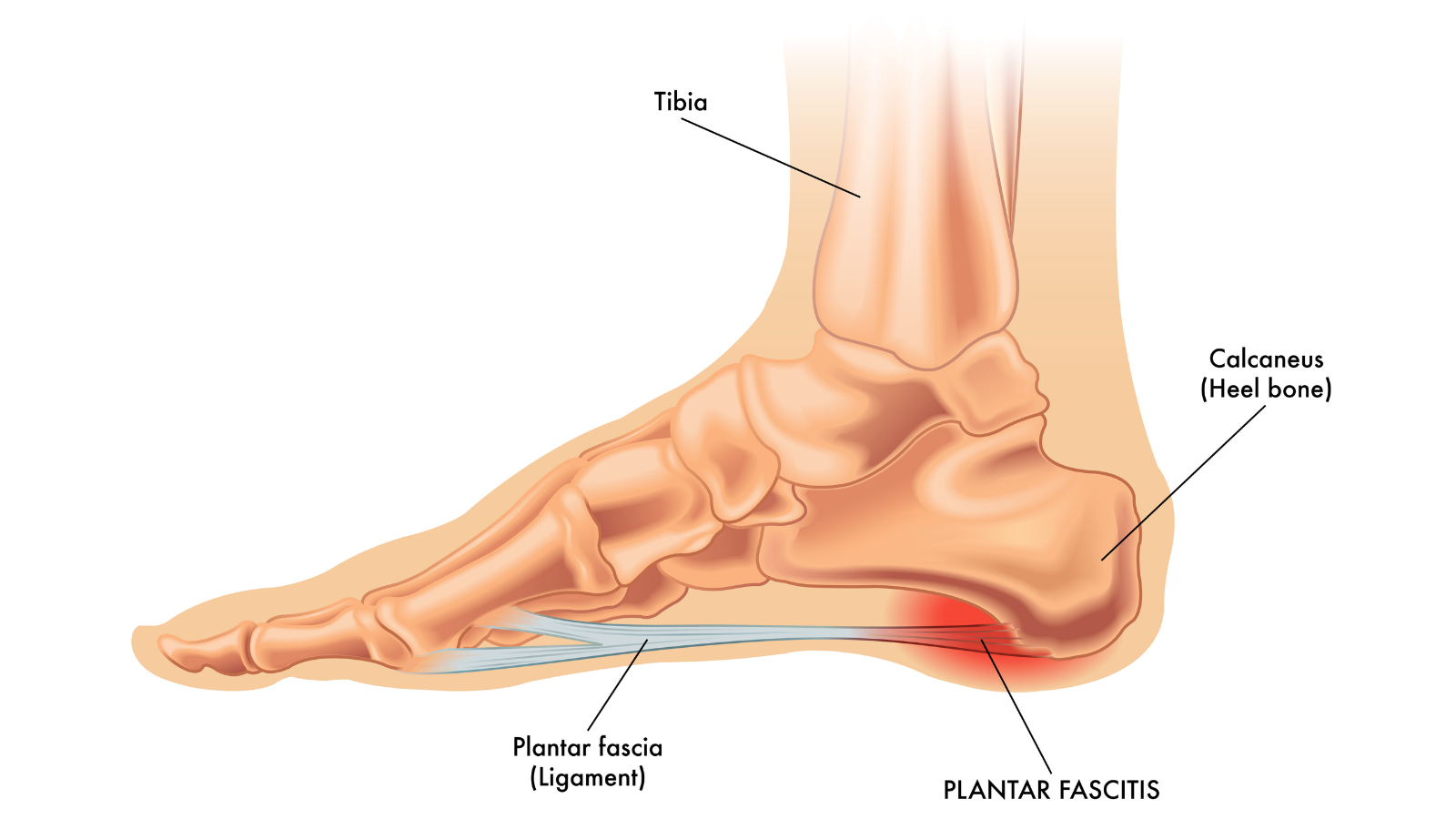
Choosing more structured footwear with arch support can relieve the discomfort. In addition, practicing exercises that stretch the fascia can help. Plantar fasciitis and tight calves typically go hand-in-hand. So stretching the calves and hamstrings can help to decrease foot pain. This is where yoga can help. With proper alignment, many standing yoga poses can work to bring flexibility back to the calves, hamstrings, and soles of the feet.
10-Minute Yoga Sequence for Plantar Fasciitis
Mountain (Tadasana)
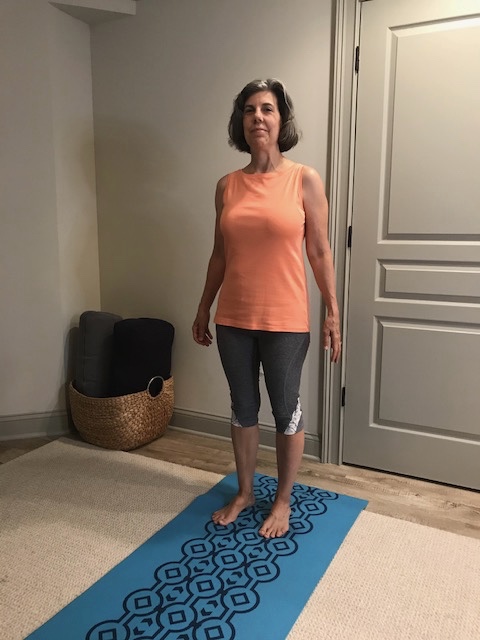
Standing poses like this one are a great way to strengthen your legs and feet, stretch the fascia, and relax your body.
- Begin by standing upright with your feet parallel and a few inches apart.
- Lift the balls of your feet gently, then lower them back down. Rock forward and back a few times, then side to side, finally coming to a stillness with your weight balanced across both feet.
- To ensure that your weight is evenly distributed across the bottoms of the feet, focus on rooting down through the “four corners” of each foot: first, the mound of the big toe, then the outer edge of the heel, followed by the inner edge of the heel, and finally the mound of the little toe. You can think of these corners as being like the tires on your car. For safety and the greatest stability, you want all four “tires,” or corners, of your feet to rest equally on the ground.
- Gently lift the inner arches without scrunching up the toes. Stay here for 3 to 6 breaths.
Prancing Feet

This next pose is great for building flexibility and strength in the fascia and toes. This pose can be challenging for your balance. So feel free to hold onto a wall, a table or the back of a chair.
- From Mountain, slowly lift your right heel off the ground on inhalation and roll onto the ball of your foot.
- As you exhale, gently lower the foot back to the ground. Repeat the motion with the left foot.
- Continue alternating sides in a fluid prancing motion for 3 to 6 breaths.
Runner’s Stretch

Runner’s stretch lengthens the Achilles tendon and calf muscles. This is best done facing a wall or inward-opening door.
- Stand about a foot from a wall, placing your hands at about waist height on the wall.
- Step your right foot 2 to 3 feet behind you, aiming the toes of both feet toward the wall.
- Lean forward on a diagonal, keeping your spine long and the back heel firmly pressed into the floor. Bend your elbows until you feel a stretch in the right calf muscles. Stay here for several breaths.
- Next, bend your right knee while keeping your right heel down (or hovering close to the floor). The heel should be directly in line with the ball of your right foot.
- Continue to root down with the ball of the right foot as you reach back through the heel. Hold here for several breaths before slowly releasing and stepping the right foot forward.
- Pause, taking a few deep breaths, before repeating on the left.
Fascia Stretch from Tabletop Pose (Bharmanasana)
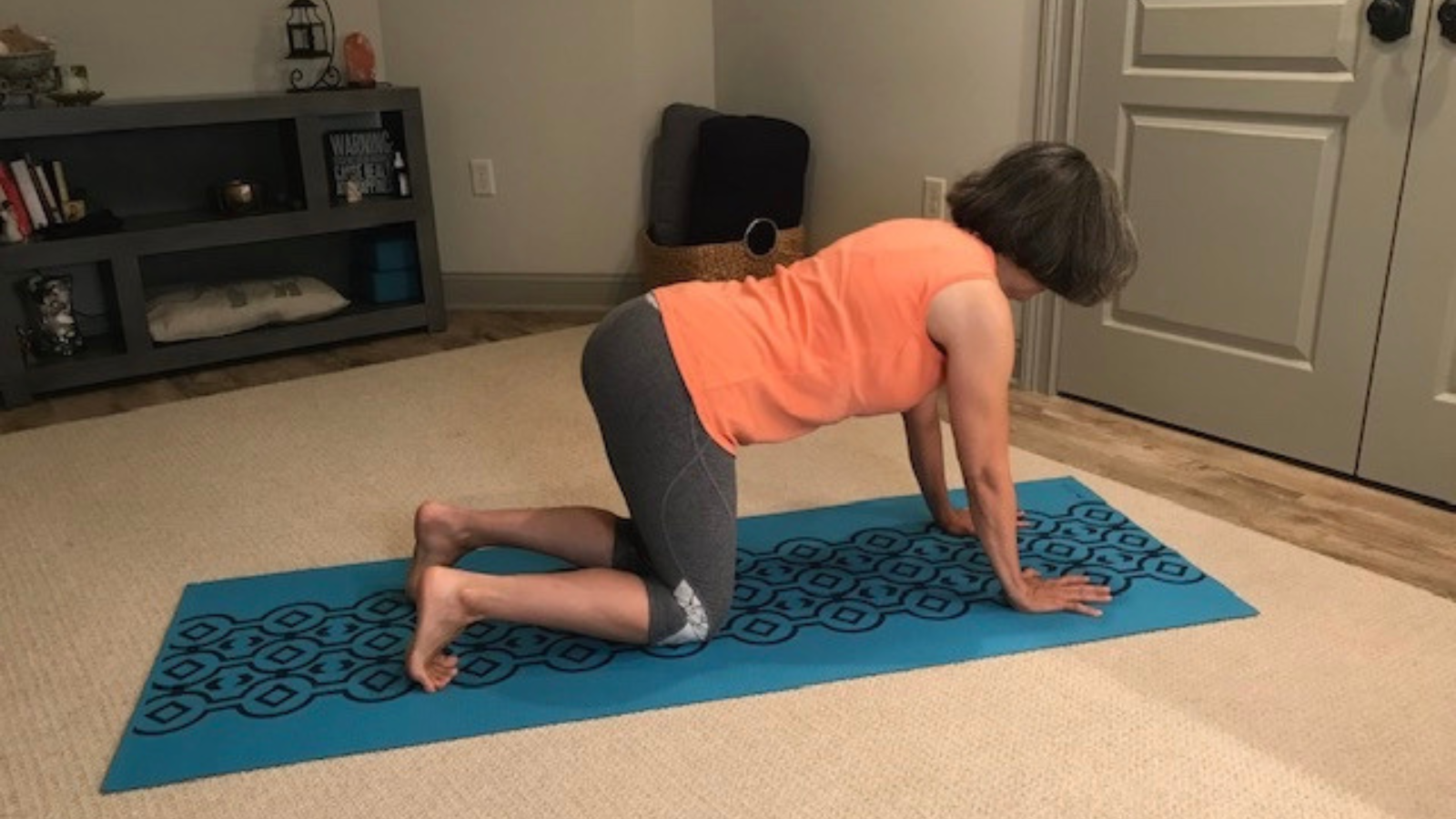
This exercise provides a nice opening stretch to the entire foot to release pressure in the plantar fascia. It can be intense, so move slowly and back off if it is too intense. Also, if you have bunions, you may want to skip this pose as your toes may lack the necessary range of motion.
- Come to Tabletop Pose (Bharmanasana) on your hands and knees. Make sure your hands are beneath your shoulders, and your knees are beneath your hips. Curl your toes under so the heels point up. Pause here for a few breaths and notice how the bottoms of your feet feel. This may be enough, but if you’d like to deepen the stretch, move on to the next step.

- To deepen the stretch in the fascia, slowly sink your hips back toward your heels until you feel a deeper stretch along the soles of the feet. If you don’t feel a stretch, you can bring your torso upright to sit on your heels, keeping your toes curled under. Make sure not to stretch your feet so much that you feel pain, but enough to feel a deep stretch.
- Hold here for several breaths, then come back to Tabletop Pose. As a counter stretch, you may choose to flatten the tops of the feet, so the toenails are pressing down. Again, slowly shift your weight back and come back to sit on the heels for several breaths. You can repeat both stretches once or twice more if you like.
Foot Massage
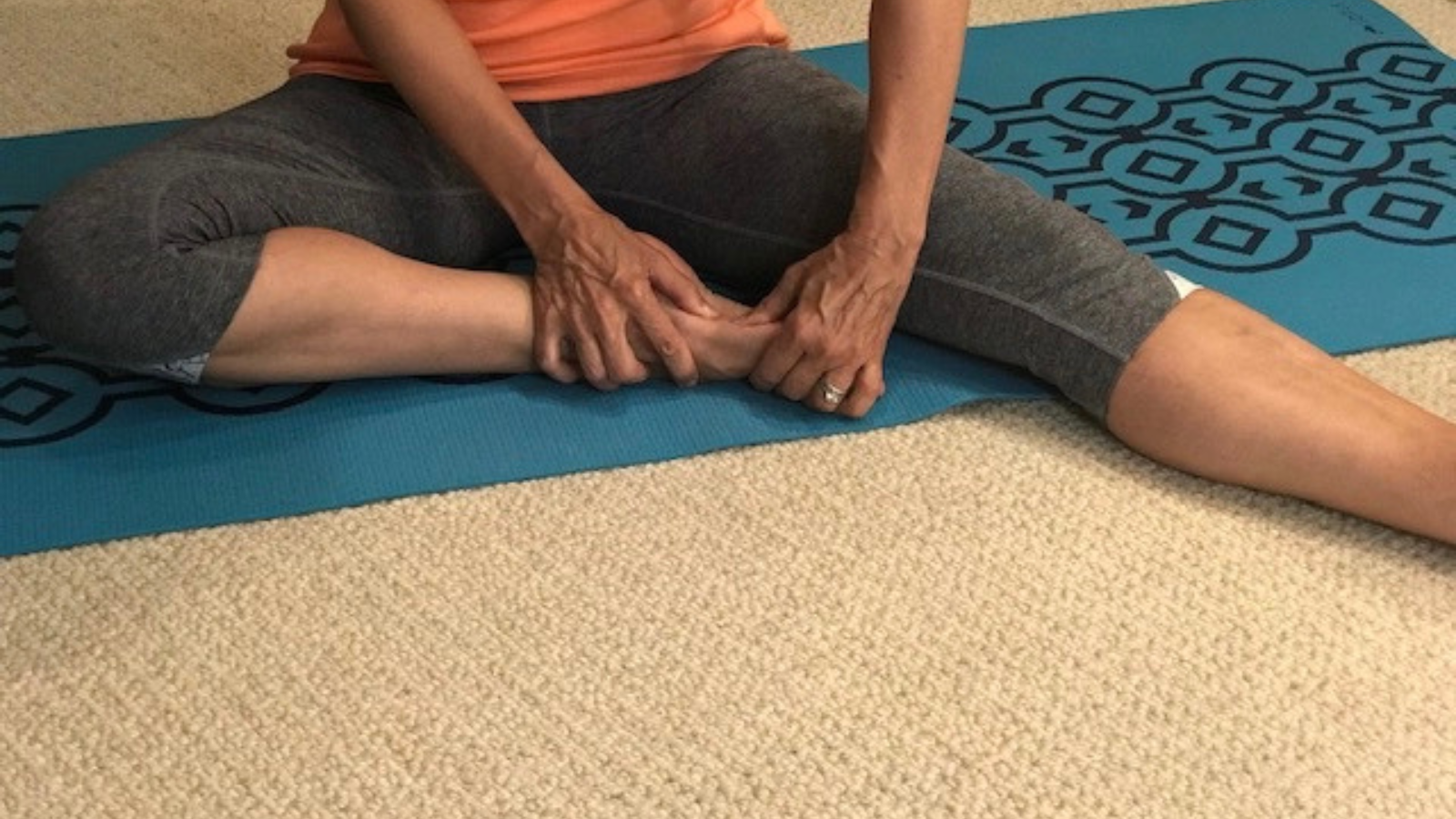
A nice alternative to this foot massage is to roll a chilled or frozen plastic water bottle back and forth under the bottoms of your feet from either a standing or seated position.
To complete your practice, sit on the floor in Staff Pose (Dandasana).
- Bend your right knee toward your groin, extending your left leg out at an angle.
- Use both of your thumbs to press along the inner arch of the right foot for 30 to 45 seconds.

- Finally, wrap your left hand around the top of your foot, palm on the sole of the foot, and fingers wrapped around the front of the toes. Hold your heel with your left hand, fingers to the outer edge of your heel.
- Begin to press the toes and heel in opposite directions, as if you were kneading bread dough for 1 to 2 minutes.
- Release your right foot and take a couple of breaths before repeating the massage on your other foot.
Summer and plantar fasciitis don’t have to go hand-in-hand. With self-care and attention to summer footwear, you can enjoy all the season has to offer.
Also, read...
7 Steps to Freedom from Neck Tension
Nov 08 – Olga Kabel C-IAYT
Has Evil Qi Settled in Your Joints? Yin Yoga Can Help
Mar 28 – Josh Summers
5 Yoga Moves for Hands and Wrists
Mar 12 – Barrie Risman
Related courses
Reprinted with permission from Wisdom Tree Yoga.com

Beverly Davis-Baird, MA, e-RYT200/RYT 500, C-IAYT is a New Jersey-based yoga therapist, writer, and educator. She specializes in making yoga accessible for adults 50+, offering classes and workshops for back care, arthritis, bone health, balance, posture, and healthy aging. An educator at heart with over 20 years of experience as a public school teacher, Beverly brings her knowledge of individual learning styles to her classes, providing instruction that is clear, concise, inclusive, and compassionate. Bringing over 30 years of experience and training, she considers herself a lifelong learner and believes that the practice of yoga should bring spaciousness and release from tension, not create it. As such, she strives to make yoga accessible to people of differing abilities, believing the real benefits of yoga come from what is taken with you outside of class and into your life. To read her blog or learn more about her teaching schedule and latest offerings, please visit www.wisdomtreeyoga.com.
Recent articles
Could Your Yoga Practice Not Just Help Improve Your Health—But Also Keep the Doctor Away?
Dec 20 – Eva Norlyk Smith, Ph.D.
4 Ways to Fit Yoga into Your Day—No Leggings Required
Dec 20 – Kathryn Boland, R-CYT, R-DMT
Asana Is a Question – Shifting from Performance to Presence in Yoga (Free Video with Judith Hanson Lasater)
Dec 18 – Eva Norlyk Smith, Ph.D.
Categories
Upcoming courses
Recent articles
Almost there...
Sorry, we couldn't find anything...
Yoga Research
Could Your Yoga Practice Not Just Help Improve Your Health—But Also Keep the Doctor Away?
We’ve all heard the saying “An apple a day keep the doctor away.” But…
Dec 20 – Eva Norlyk Smith, Ph.D.
Pose Library
4 Ways to Fit Yoga into Your Day—No Leggings Required
As a yoga instructor and practitioner, I can see that for many people, one…
Dec 20 – Kathryn Boland, R-CYT, R-DMT
Yoga Teaching
Asana Is a Question – Shifting from Performance to Presence in Yoga (Free Video with Judith Hanson Lasater)
Discovering the True Purpose of Your Yoga Practice Here’s a question for you: When…
Dec 18 – Eva Norlyk Smith, Ph.D.



